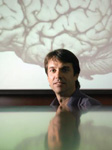Brain's timescale depends on the nature of the visual stimulus

Washington, September 6 : A team of Harvard bioengineers and brain scientists have studied the way the brain rapidly and precisely encodes natural visual events that occur on a slower timescale.
The researchers say that their study has taken them one step further towards unravelling the cryptic code used by the neurons of the brain to represent the natural visual world.
"Visual perception is limited by the relatively slow way in which the neurons in our eyes integrate light. This is why, for example, a Hollywood movie consisting of a series of flickering images appears to us as seamless motion," Nature magazine quoted Garrett Stanley, Associate Professor of Biomedical Engineering at the Harvard School of Engineering and Applied Sciences, as saying.
"However, when the brain responds to some kind of visual event, such as a ball bouncing, the activity of the neurons responsible for sending information can be precise down to the millisecond, despite the fact that the motion of the ball is much slower," the researchers added.
For determining why the brain might encode visual information with such precision, the researchers relied on data obtained by directly recording neuronal activity in animals as they viewed natural scene movies. Doing so enabled them to pinpoint the pattern of neuronal firings in cells that respond to form and motion.
The researchers say that their analysis suggests that the brain's timescale depends on the nature of the visual stimulus, meaning that the precise timing of the neurons changes relative to the timescale of the visual scene.
They corroborate their finding with an illustration, saying that a faster bouncing ball results in more precise brain activity than a slower one. In each case, however, the precision of the neurons' activity was several times that of the speed of the bouncing ball.
It turns out that the extreme precision of the brain's neural response to visual stimuli is, paradoxically, necessary to accurately represent the more slowly changing visual world. The neuron's response must be more precise to recover the important aspects of the visual environment.
"We believe that this type of relative precision may be a general feature of sensory neuron communication. You can think of it like digital sampling used for audio recordings. The brain 'digitizes' the visual stimulus. As with digital audio recordings, for clear and representational 'playback', the encoding frequencies must be at least double that of the signal information," says Stanley.
The researchers are now planning to study why and how the brain encodes visual information across larger networks of cells and across functional units of the brain. They will also investigate how the visual pathway of the brain adapts to changes in the visual scene.
The researchers believe that cracking the neural code will help scientists and engineers better "communicate" with the brain.(With Inputs from ANI)